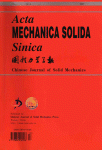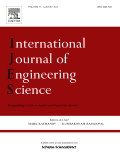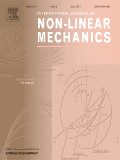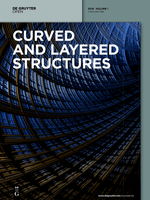
ACTA MECHANICA SOLIDA SINICA
Scope & Guideline
Connecting Researchers in the Realm of Solid Mechanics
Introduction
Aims and Scopes
- Solid Mechanics and Structural Analysis:
The journal covers fundamental and applied research in solid mechanics, including the analysis of materials and structures under various loading conditions using advanced computational and experimental techniques. - Materials Science and Engineering:
Research on the mechanical properties, behavior, and processing of materials, including metals, polymers, composites, and nanomaterials, is a core focus area. - Computational Mechanics:
The use of computational methods such as finite element analysis, molecular dynamics simulations, and peridynamics to study complex mechanical behavior and material interactions. - Dynamic and Nonlinear Analysis:
Investigation into dynamic responses and nonlinear behavior of structures, including vibration, buckling, and impact analysis. - Multiscale and Multifield Coupling:
Research addressing the interactions between different physical fields (thermal, mechanical, electromagnetic) and across various scales, from micro to macro. - Innovative Design and Optimization:
Studies that propose new designs or optimization techniques for mechanical systems, often leveraging advanced algorithms and machine learning.
Trending and Emerging
- Machine Learning and AI in Mechanics:
The integration of machine learning and artificial intelligence techniques in mechanical analysis and material design is gaining traction, reflecting the broader trend of data-driven research. - Functionally Graded Materials and Structures:
Research focusing on functionally graded materials and structures is on the rise, driven by their unique properties and applications in aerospace, biomedical, and structural engineering. - Metamaterials and Mechanical Metamaterials:
The exploration of novel metamaterials, particularly those exhibiting unusual mechanical properties such as negative Poisson's ratio and tunable band gaps, is becoming increasingly prominent. - Biomimetic and Bio-inspired Designs:
Studies that draw inspiration from biological systems to develop new materials and structures are trending, particularly in the context of energy absorption and lightweight design. - Sustainability and Green Materials:
Research that emphasizes sustainable practices and the development of eco-friendly materials is emerging as a significant theme in response to global environmental challenges.
Declining or Waning
- Traditional Materials Testing:
Research focused solely on conventional materials testing methods has decreased, possibly due to the rise of advanced materials and the need for more complex analyses involving computational models. - Simplified Analytical Models:
The reliance on simplified analytical models for predicting mechanical behavior is declining as researchers increasingly favor more sophisticated computational approaches that can capture complex phenomena. - Static Analysis of Structures:
Studies primarily dedicated to static analysis without considering dynamic effects or real-world loading conditions are becoming less common as the field shifts towards more holistic approaches. - Purely Theoretical Studies:
Although theoretical contributions remain important, there is a noticeable decline in purely theoretical studies without experimental validation or practical applications. - Traditional Manufacturing Techniques:
Research that focuses exclusively on traditional manufacturing processes is waning, with a growing emphasis on additive manufacturing and advanced fabrication techniques.
Similar Journals

ACTA MECHANICA
Advancing Computational Mechanics and EngineeringACTA MECHANICA, published by Springer Wien, is a reputable journal that has been an integral part of the fields of Computational Mechanics and Mechanical Engineering since its inception in 1965. With a strong emphasis on innovative research and advanced methodologies, the journal has established itself in the academic community, currently holding a distinguished Q2 ranking in both categories for 2023. The journal’s ISSN is 0001-5970, with an E-ISSN of 1619-6937. Furthermore, it proudly ranks #26 out of 89 in Computational Mechanics and #217 out of 672 in Mechanical Engineering in the Scopus database, placing it in the top percentiles of its respective fields. Researchers, professionals, and students can access cutting-edge articles that cover a wide range of topics, contributing significantly to ongoing dialogues and discoveries within mechanical disciplines. Though not an open-access journal, ACTA MECHANICA offers a platform for highly qualified researchers to disseminate their work, ensuring that significant findings advance the field's boundaries. For more information, visit the journal’s address at Prinz-Eugen-Strasse 8-10, A-1040 Vienna, AUSTRIA.

MECCANICA
Fostering Collaboration in Cutting-edge ResearchMECCANICA, an esteemed journal published by Springer, stands at the forefront of research in the fields of Condensed Matter Physics, Mechanical Engineering, and Mechanics of Materials. Established in 1966 and continuing through 2024, this journal provides a robust platform for the dissemination of innovative research and advancements in these increasingly interconnected domains. With an impressive 2023 ranking placing it in the Q2 category across multiple fields, MECCANICA boasts a Scopus rank of #198 in Mechanical Engineering, #150 in Condensed Matter Physics, and #141 in Mechanics of Materials, highlighting its significance and influence within the scholarly community. The journal aims to foster dialogue among researchers, professionals, and students, facilitating the exchange of cutting-edge ideas and methodologies crucial for overcoming contemporary engineering and physics challenges. Readers can access a wealth of knowledge through its comprehensive articles, and while it does not currently offer open access, the journal remains instrumental in shaping the future of engineering and physical sciences.

Materials Physics and Mechanics
Innovating Insights in Physics and EngineeringMaterials Physics and Mechanics is a pivotal journal dedicated to advancing the fields of condensed matter physics, materials science, mechanical engineering, and the mechanics of materials. Published by the Institute of Problems in Mechanical Engineering, Russian Academy of Sciences, this journal has established itself as a valuable resource since its inception, particularly from 2003 to 2004 and now continuously from 2009 to 2024. Although it currently holds a Q4 categorization in various disciplines, its contributions are critical to understanding and developing new materials and their applications in engineering. The journal provides insightful articles that explore the nuances of material properties, their behaviors under different conditions, and the physical principles governing these phenomena. Though it operates under a traditional publication model, the insights provided within its pages are invaluable to researchers, professionals, and students striving to push the boundaries of knowledge in the materials domain. Its ISSN numbers (1605-2730, E-ISSN 1605-8119) serve as a gateway to a wealth of scientific knowledge emanating from the Russian Federation, contributing to the global discourse in materials physics and mechanics.

INTERNATIONAL JOURNAL OF ENGINEERING SCIENCE
Exploring Cutting-Edge Research for Tomorrow's EngineersInternational Journal of Engineering Science, published by Pergamon-Elsevier Science Ltd in the United Kingdom, stands as a premier platform for pioneering research in the diverse fields of engineering and materials science. Since its inception in 1963, this journal has consistently demonstrated its commitment to advancing academic discourse, maintaining an impressive trajectory that positions it in the Q1 category across multiple engineering disciplines including Mechanical Engineering and Mechanics of Materials as of 2023. With notable Scopus rankings—placing it in the top 5% percentile for Mechanical Engineering and related fields—this journal attracts high-quality, impactful research designed for both industry practitioners and academic scholars. Although it does not currently offer Open Access options, its readership is enriched by comprehensive peer-reviewed articles, fostering a deeper understanding of complex engineering problems and innovative solutions. The International Journal of Engineering Science continues to be an invaluable resource for researchers, professionals, and students committed to pushing the boundaries of knowledge in engineering and materials science.

COMPUTATIONAL MECHANICS
Catalyzing Breakthroughs in Mathematical ApplicationsCOMPUTATIONAL MECHANICS, published by SPRINGER, is a premier international journal that focuses on the intersection of applied mathematics, engineering, and computational methods. With a commendable Q1 ranking in multiple categories, including Applied Mathematics and Mechanical Engineering, this journal is pivotal for disseminating groundbreaking research and innovative methodologies that advance the field. The journal has steadily contributed to the academic community since its inception in 1986 and continues to lead discussions and practices in computational mechanics and related disciplines. With a robust impact reflected in its Scopus rankings—placing it within the top percentiles across various categories—COMPUTATIONAL MECHANICS serves as a crucial platform for researchers, professionals, and students seeking to explore and contribute to significant advancements in computational theory and mathematical applications. Although it does not currently operate under an open access model, the journal ensures wide accessibility through libraries and institutional subscriptions, fostering a rich exchange of knowledge in the global scientific community.

Coupled Systems Mechanics
Pioneering Research in Mechanics of MaterialsCoupled Systems Mechanics is a pioneering journal in the fields of Civil and Structural Engineering and Mechanics of Materials, published by TECHNO-PRESS. With an ISSN of 2234-2184 and an E-ISSN of 2234-2192, this journal actively contributes to the academic discourse surrounding coupled system mechanics, addressing complex interactions within engineering disciplines. Hailing from South Korea, the journal has been committed to disseminating high-quality research since its inception, converging years from 2017 to 2024. It holds a respectable Q3 ranking in both Civil and Structural Engineering and Mechanics of Materials, indicating its relevance and impact within these fields. Researchers, professionals, and students can expect cutting-edge studies and innovative methodologies, as the journal consistently aims to enhance understanding and application of coupled systems in engineering. Although it operates under a subscription model, it remains an essential resource for those looking to stay at the forefront of advancements in engineering sciences.

Forces in Mechanics
Disseminating Cutting-Edge Research in MechanicsForces in Mechanics is a premier open access journal published by ELSEVIER that has carved out a significant niche in the realms of Mechanical Engineering and Mechanics of Materials. Established in 2020 and based in the Netherlands, this journal aims to disseminate high-quality research that explores the fundamental principles and applications of forces within mechanical systems. It operates under the ISSN 2666-3597, showcasing a dedication to transparent and accessible research for scholars around the globe. With a 2023 impact factor ranking placing it in the Q2 quartile for both Mechanical Engineering and Mechanics of Materials, the journal is recognized for its contributions to the field, evidenced by its Scopus ranking—285th in Mechanical Engineering and 184th in Mechanics of Materials, placing it in the 57th and 53rd percentiles, respectively. The journal publishes original research articles, reviews, and technical notes, catering to a diverse audience including researchers, practitioners, and students who are keen to advance their knowledge on the dynamics of forces in mechanical contexts. As it converges from 2021 to 2024, Forces in Mechanics remains committed to providing a platform for innovative research and critical discourse, ensuring that all published work is freely available to the global community.

INTERNATIONAL JOURNAL OF NON-LINEAR MECHANICS
Illuminating the Path of Non-Linear MechanicsWelcome to the International Journal of Non-Linear Mechanics, a premier publication dedicated to advancing the understanding of non-linear behavior in mechanical systems. Published by Pergamon-Elsevier Science Ltd, this esteemed journal has been an influential platform since its inception in 1966 and continues its rigorous exploration of specialized topics until 2024. With a strong focus on applied mathematics, mechanical engineering, and mechanics of materials, it holds an impressive Q1 ranking in both mechanical engineering and mechanics of materials, and a Q2 ranking in applied mathematics, underscoring its significance in these fields. Notably, it ranks 81st out of 635 in Applied Mathematics, highlighting its vital contribution to the literature. The journal's commitment to quality research is reflected in its indexing in Scopus and its prominent impact within the academic community. Although not an open access journal, it remains accessible to researchers and professionals seeking cutting-edge innovations and breakthroughs in non-linear mechanics. We invite scholars, practitioners, and students alike to engage with the pivotal research published in this journal as they advance their own works in the dynamic landscape of engineering and applied sciences.

Curved and Layered Structures
Transforming Ideas into Architectural MasterpiecesCurved and Layered Structures, published by DE GRUYTER POLAND SP Z O O, is a distinguished open-access journal that has been an essential platform since 2014 for academics and professionals in the fields of Aerospace Engineering, Architecture, Building and Construction, Civil and Structural Engineering, and Computational Mechanics. With an ISSN of 2353-7396, it is recognized for its impactful contributions, reflected in its impressive category quartiles, particularly Q1 in Architecture and notable rankings in various engineering disciplines. The journal's scope encompasses innovative research focusing on the intricate designs and applications of curved and layered structures, making it pivotal for advancing knowledge in these areas. The open-access format ensures widespread dissemination of research findings, promoting accessibility and collaboration among researchers and practitioners worldwide. As it navigates its converged years from 2014 to 2024, Curved and Layered Structures continues to attract high-quality submissions that push the boundaries of engineering and architectural design.

ACTA MECHANICA SINICA
Advancing the Frontiers of Mechanical EngineeringACTA MECHANICA SINICA is a prestigious journal published by SPRINGER HEIDELBERG that has been a cornerstone in the field of mechanical engineering and computational mechanics since its inception in 1985. Based in Germany, this leading publication is internationally recognized for its high impact, holding a Q1 ranking in both Computational Mechanics and Mechanical Engineering as of 2023. It is positioned prominently within the academic community, evidenced by its respectable Scopus rankings—#21 in Computational Mechanics and #159 in Mechanical Engineering, both within the 76th percentile. Researchers and professionals alike turn to ACTA MECHANICA SINICA for cutting-edge research, innovative methodologies, and insights that drive advancements in the discipline. Although the journal is not open access, its rigorous peer-review process ensures the publication of high-quality, impactful research that is essential for scholars and practitioners aiming to stay at the forefront of mechanical engineering advancements.